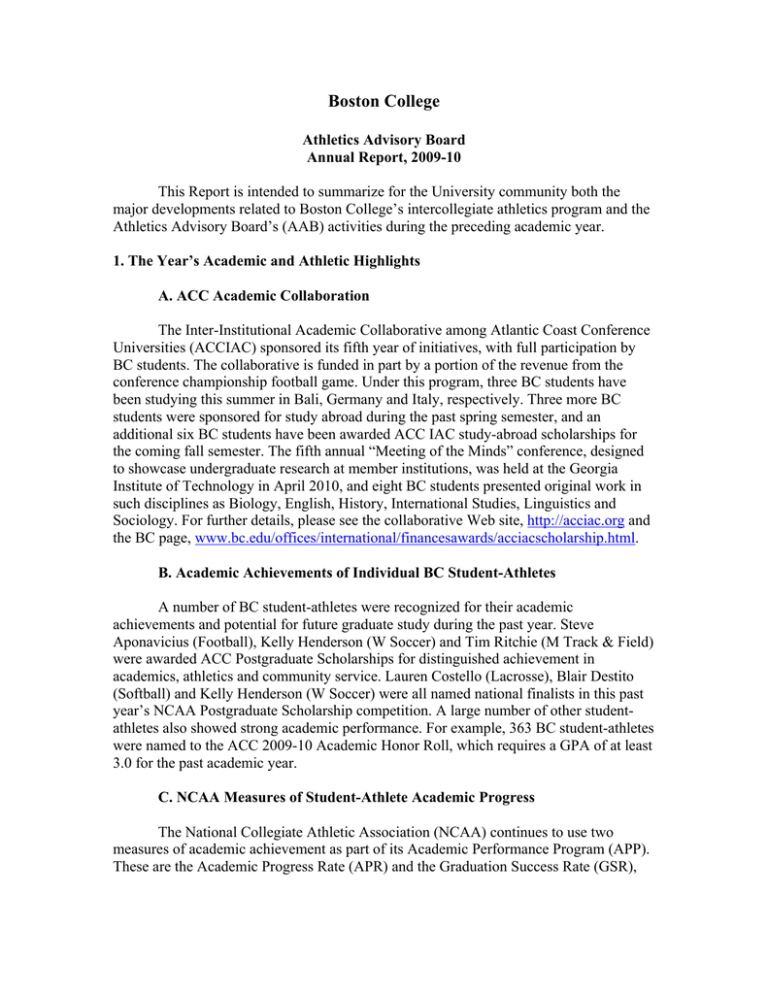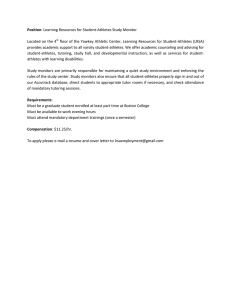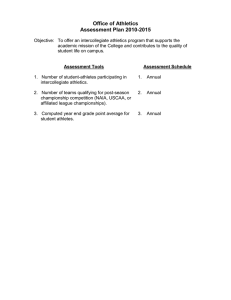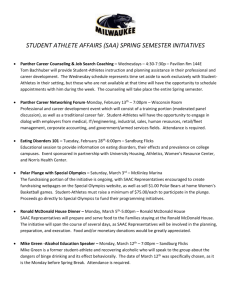Boston College
advertisement

Boston College Athletics Advisory Board Annual Report, 2009-10 This Report is intended to summarize for the University community both the major developments related to Boston College’s intercollegiate athletics program and the Athletics Advisory Board’s (AAB) activities during the preceding academic year. 1. The Year’s Academic and Athletic Highlights A. ACC Academic Collaboration The Inter-Institutional Academic Collaborative among Atlantic Coast Conference Universities (ACCIAC) sponsored its fifth year of initiatives, with full participation by BC students. The collaborative is funded in part by a portion of the revenue from the conference championship football game. Under this program, three BC students have been studying this summer in Bali, Germany and Italy, respectively. Three more BC students were sponsored for study abroad during the past spring semester, and an additional six BC students have been awarded ACC IAC study-abroad scholarships for the coming fall semester. The fifth annual “Meeting of the Minds” conference, designed to showcase undergraduate research at member institutions, was held at the Georgia Institute of Technology in April 2010, and eight BC students presented original work in such disciplines as Biology, English, History, International Studies, Linguistics and Sociology. For further details, please see the collaborative Web site, http://acciac.org and the BC page, www.bc.edu/offices/international/financesawards/acciacscholarship.html. B. Academic Achievements of Individual BC Student-Athletes A number of BC student-athletes were recognized for their academic achievements and potential for future graduate study during the past year. Steve Aponavicius (Football), Kelly Henderson (W Soccer) and Tim Ritchie (M Track & Field) were awarded ACC Postgraduate Scholarships for distinguished achievement in academics, athletics and community service. Lauren Costello (Lacrosse), Blair Destito (Softball) and Kelly Henderson (W Soccer) were all named national finalists in this past year’s NCAA Postgraduate Scholarship competition. A large number of other studentathletes also showed strong academic performance. For example, 363 BC student-athletes were named to the ACC 2009-10 Academic Honor Roll, which requires a GPA of at least 3.0 for the past academic year. C. NCAA Measures of Student-Athlete Academic Progress The National Collegiate Athletic Association (NCAA) continues to use two measures of academic achievement as part of its Academic Performance Program (APP). These are the Academic Progress Rate (APR) and the Graduation Success Rate (GSR), 2 and they are applied at each NCAA Division I member school for all student-athletes who receive athletically-related financial aid. The APR looks at the eligibility, retention and graduation of all athletically-aided student-athletes (and, for teams that do not award athletic aid, all recruited studentathletes). The APR awards 1 point for each student-athlete who is academically eligible to compete in the next semester and an additional point if that student-athlete returns to school for the next semester. For the academic year, therefore, each student-athlete could receive a maximum of four points for the fall and spring semesters. The APR compares the total number of points actually received in a given year to the maximum total points. The primary use of the APR measure is on a team-by-team, rather than an overall institutional basis. The NCAA has imposed a cutoff APR of 925 (i.e., 92.5% of the maximum total points), and any school with a team whose four-year average APR falls below that level in its sport may be subject to penalties in the form of reductions of the maximum allowable financial aid for that sport. Based on the most recent data, none of BC’s teams were subject to these penalties. In addition, 13 of BC’s teams received public recognition from the NCAA for having an APR among the top 10% of Division I institutions sponsoring that sport. Further details can be found on the NCAA Web site: www.ncaa.org, under Academics. The second measure of academic performance used by the NCAA is the Graduation Success Rate (GSR), which measures the percentage of student-athletes entering an institution who graduate from that institution, excluding students who transfer to another institution while still academically eligible to compete at their initial institution. The latest data available cover students entering college in 1999, 2000, ’01 and ‘02. For Boston College student-athletes overall, the four class average GSR was 96%, compared to a GSR of 79% for all Division I institutions combined. Twenty-one of the varsity sports that BC currently sponsors achieved the highest possible GSR of 100%. Further details on graduation rates for individual sports and other NCAA schools can be found at www.ncaa.org, under Academics. The NCAA notified Boston College in May, 2010 that it has been chosen to have its APR data reviewed. This is an audit process for which a group of Division I institutions is selected each year. Over a period of time, all Division I institutions will be selected. Boston College has submitted all data requested by the NCAA. That data has been reviewed, a preliminary report was submitted to Boston College in August of 2010, and Boston College has responded to the preliminary report. We are currently awaiting a final report from the NCAA’s Subcommittee on Data Collection and Reporting. D. ACC Compliance Review At least once every four years, the Atlantic Coast Conference undertakes an oncampus Compliance Review of each of its member institutions in accordance with an NCAA Bylaw, which calls for a periodic compliance review “by an authority outside of the athletics department.” BC’s last external review was conducted in the spring of 2006, 3 and this year’s review was conducted in February 2010. The review is intended to evaluate and improve procedures in place to ensure compliance with NCAA rules and to “strengthen the institution’s overall control and integrity of the athletics program.” Among the areas reviewed are the institution’s governance and organization of its athletics program, procedures for certifying student-athlete eligibility, academic support for student-athletes, procedures for maintaining and reporting data for the NCAA’s Academic Performance Program and procedures for recruiting and awarding financial aid to student-athletes. The report based on this review, received by Boston College in March 2010, made some suggestions for improvement, but concluded overall that “…the compliance systems at Boston College are sound and complete” and that “The overall organization and structure … displays a high level of commitment from the institution at all levels of administration.” E. Athletic Program Highlights BC teams achieved considerable success on the playing field during the past year. In the fall, the football team won 8 games and made its 11th consecutive bowl game appearance in the 2010 Emerald Bowl game in San Francisco, where it was defeated by the University of Southern California. Women’s Soccer tied for the ACC regular-season conference title and advanced to the “Elite Eight” of the NCAA tournament. Men’s Soccer was also selected for the NCAA tournament and advanced to the “Round of 16.” In the winter, the men’s ice hockey team won the Beanpot championship, the Hockey East championship and its third NCAA national championship in the past decade. The women’s basketball team advanced to the semifinal round of the ACC tournament for the first time, before losing to North Carolina State. In the spring, the sailing team won the Inter-Collegiate Sailing Association (ICSA) national coed championship. Together with the 2008 Women’s title and the 2008 and ’09 team titles, this marks BC sailing’s fourth national title in the past three years. The BC sailing team also won the Fowle “Team of the Year” Trophy for the second time in three years. 2. AAB Activities during 2009-10 A. AAB Monthly Meetings The minutes of all eight AAB meetings held during 2009-10 are attached to this report. Our guests this year included Donald Hafner and Joseph Burns, Vice Provost and Associate Vice Provost, respectively, for Undergraduate Academic Affairs; Head Coaches Mikio Aoki (Baseball) and Bowen Holden (Lacrosse); several members of the BC Student-Athlete Advisory Committee (SAAC); Vice President for Student Affairs Patrick Rombalski; and the counseling and administrative staff of Learning Resources for Student-Athletes (LRSA). The AAB’s monthly meetings were dominated this past year by four fundamental themes, all of which have come up for discussion in recent years as well. These are: (1) student-athlete involvement in academic integrity cases, (2) Academic support and 4 advising for student-athletes, (3) practice and competition schedules and the difficulties they pose for student-athletes in balancing academics and athletics, and (4) the place of student-athletes in the broader community life of the University. The AAB heard a variety of perspectives on these issues, including those of coaches, student-athletes, administrators, and academic support staff and also had the opportunity to examine some data gathered by the Office of Institutional Research. Academic integrity was the topic of our October meeting with guests Don Hafner and Joe Burns, but we returned to the issue in subsequent meetings with Patrick Rombalski and with the LRSA staff. One issue surrounding the general topic that had previously arisen was that of whom to inform when student-athletes are accused of academic integrity violations by faculty. Vice Provost Don Hafner expressed the opinion that such violations are an academic matter and should be reported to an academic unit of the University, such as LRSA. However, he also pointed to a number of sticky procedural issues, including possible lack of knowledge at the Academic Integrity Board level of the different colleges that a particular student involved in a case is also a student-athlete and reluctance to disclose information before a case has been adjudicated. Considerable time was also spent discussing efforts around the University to educate all students about the meaning of academic integrity in various contexts and particularly about the rules for proper citation of sources of information. Joe Burns described the online academic integrity tutorial that all BC freshmen must now successfully complete before being allowed to register for second semester courses. The LRSA counselors also described in detail their efforts to provide education on proper citation, particularly to academically at-risk student athletes, who may lack experience in writing research papers prior to entering BC. In addition, the counselors also described the extensive training and certification undergone by LRSA tutors to make it clear to them what type of help is appropriate to extend to a student-athlete and what type is not. At LRSA’s invitation, AAB Chair Bob Taggart and Director of Institutional Research Jess Greene made a follow-up visit to the LRSA office on August 2, 2010, to learn more about tutor training and documentation of tutor observations by senior staff members. Vice President for Student Affairs Patrick Rombalski also discussed academic integrity during his visit to the AAB’s April meeting and he expressed the opinion that cheating cannot be dealt with solely in the classroom. He described a University-wide initiative that is currently underway to help instill integrity and other values as core values of the University community. Based on research studies that he had seen, he expressed doubt that integrity problems arose primarily among student-athletes, which echoed similar doubts expressed by Don Hafner at the October meeting. The second major theme of the monthly AAB meetings was academic support and advising for student-athletes. Concerning different possible sources of advising assistance, the delegation of student-athletes from the SAAC, who attended our December meeting, argued that LRSA counselors are highly knowledgeable about team practice and competition schedules and can offer help in balancing course and practice schedules. At the same time, they said that academic advisors were better equipped to offer advice about specific courses and how they might fit with future career plans. The 5 LRSA counselors echoed this sentiment in their visit to the May meeting and said that further efforts are currently underway to define more clearly the roles of different sources of academic advising help. The student-athletes also stressed that all students need to be proactive in seeking out advising help. In their November visit, the coaches felt that it would be helpful if they received an overview at the beginning of the year of different sources of advising help available so that they might better steer team members particularly freshmen and sophomores, toward the most appropriate form of help. In terms of student-athlete advising outcomes, Don Hafner offered evidence in his October visit to counter the notion that student-athlete academic advising steers them toward the same courses and majors. He argued that the distribution of student-athletes across schools and majors is not markedly different than for non-athlete BC students. It is also sometimes asserted that student-athletes’ busy schedules make them less likely to develop the types of personal relationships with faculty that can result in valuable sources of advice. However, AAB member and Director of Institutional Research Jess Greene reported some results from senior surveys at the March meeting, which did not suggest significant differences between student-athletes and non-athlete students in the degree of satisfaction with advising or in various metrics designed to assess students’ levels of academic engagement. A third major theme was practice and competition schedules in the different sports and the difficulty of balancing academics with athletics. While all varsity sports make major demands on student-athletes’ time, travel and competition schedules differ markedly depending on the nature of the sport, as was pointed out by Coaches Aoki (baseball) and Holden (lacrosse) in their November visit. The AAB conducted its annual review of playing and practice times and classes missed for competition and developed questions for the Athletics Department in its February meeting. Unexpected events forced a postponement of the scheduled March meeting with Director of Athletics Gene DeFilippo and Senior Associate Athletics Director Jody Mooradian, but AAB chair Bob Taggart followed up on these questions during the summer. As in years past, baseball, softball, volleyball and golf are among sports posing the most substantial travel schedules with attendant missed classes. An unfortunate scheduling error resulted in more missed class time right after spring vacation for baseball this past year, but that will be rectified next year, and next spring’s annual exhibition game with the Red Sox will be on a Saturday, rather than on a weekday evening prior to BC’s spring vacation, as in years past. Coach Aoki also described in his November visit how not all team members necessarily take every away trip. In softball, the practice schedule this past year was somewhat more favorable to the availability of class times to team members, and in volleyball, the conference competition schedule was scaled back somewhat, resulting in some reduction in travel. The golf travel schedule was also somewhat reduced this past year, and this coming fall, team members will have greater flexibility to choose practice times, increasing their range of available academic schedules. In response to AAB questions, the Athletics Department affirmed that the sailing and golf practice schedules include travel time to practice venues. 6 The AAB asked the SAAC representatives during their December visit to describe the difficulties they face in balancing academics with athletics. The students acknowledged that this can be difficult and that sometimes compromises are necessary, especially in terms of revising term papers or other written assignments. At the same time, they said that their schedules force them to use their time as efficiently as possible. Both the coaches and the SAAC representatives did argue that some form of priority registration for student-athletes would make it less difficult to fit required courses into their available time schedules. However, the Provost’s office has previously expressed the opinion that the override system is a more equitable means for resolving scheduling difficulties faced by all students, both athletes and non-athletes. The fourth major theme of this year’s AAB meetings was the degree of integration of student-athletes into the broader life of the University community. When asked about this, the SAAC representatives did acknowledge that the demands of athletics and academics forced them to sacrifice some of the social aspects of University life. In addition, common interests and schedules often cause them to spend a good deal of time with teammates or other student-athletes. However, they did point to a coming service immersion trip (this trip to New Orleans subsequently took place over spring vacation) that was planned around student-athlete schedules, and they said that SAAC was working on arranging some joint activities with other student groups on campus. In his April visit, Vice President for Student Affairs Patrick Rombalski talked about the need to better integrate the University generally. He felt that many campus groups, not just athletic teams, sometimes have the effect of isolating their members from the rest of the community. He discussed plans for more social and study space in future dormitories. He also pointed out that, as they stand, the dormitories do integrate all students. While student-athletes or other group members may tend to room together, they are on the same floor with other students. He also talked about new models of service activities, new freshmen welcoming programs and efforts to reduce excessive alcohol consumption as possible further steps toward breaking down barriers among all campus groups. He stated that the ultimate goal is creation of a greater sense of identification with Boston College among both students and other members of the community. B. Committee Composition At the beginning of the year, the AAB welcomed newly-elected members Bob Murphy (Economics) and Joe Pedulla (LSOE). At the end of the academic year, Bob Bloom (Law) and Paul Spagnoli (History) completed their elected terms, and Richard Albert (Law) and Kathy Bailey (Political Science) were elected by the faculty to threeyear terms, beginning June, 2010. Please feel free to seek out any AAB member with questions and concerns you may have. One of the Board’s primary functions is to serve as a channel for communication between the academic and athletic programs, and we are always open to your questions or other input. 7 The Athletics Advisory Board: Robert Bloom (Law) Mary Ellen Fulton (LSOE) Jessica Greene (Institutional Research) Michael Moore (Psychology) Robert Murphy (Economics) Joseph Pedulla (LSOE) Michael Sacco (Intersections Project) Paul Spagnoli (History) Edward Taylor (CSOM) Robert Taggart (CSOM, Chair and Faculty Athletics Representative)


